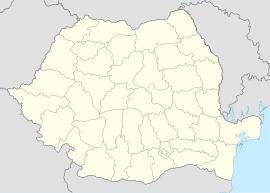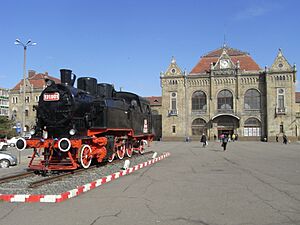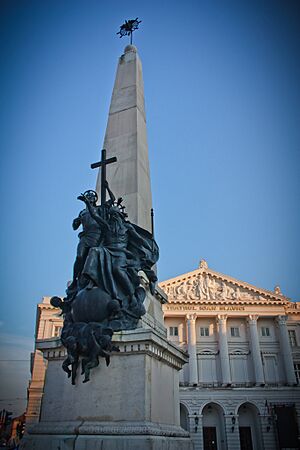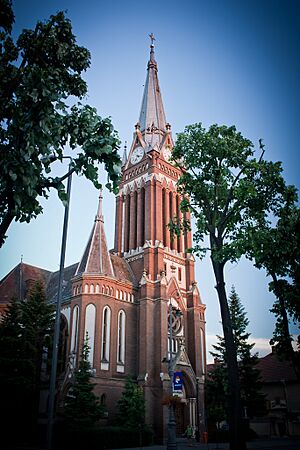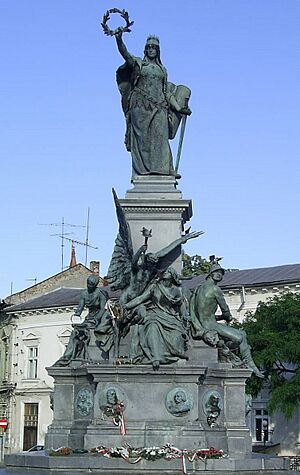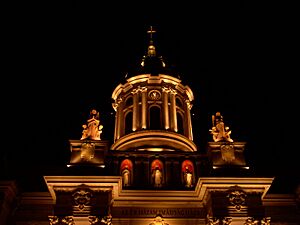Arad, Romania facts for kids
Quick facts for kids
Arad
|
|||
|---|---|---|---|
       
From top, left to right: Administrative Palace, Cenad Palace, The Red Church, St. Anthony of Padua Church, Moise Nicoară National College, Ioan Slavici Classical Theatre, Statue of St. Nepomuk, Aurel Vlaicu University
|
|||
|
|||
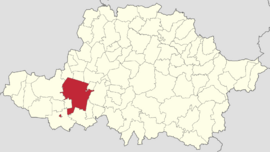
Location in Arad County
|
|||
| Country | |||
| County | Arad | ||
| Area | 46.18 km2 (17.83 sq mi) | ||
| Elevation | 117 m (384 ft) | ||
| Population
(2011)
|
Lua error in Module:Wd at line 1,575: attempt to index field 'wikibase' (a nil value). | ||
| Time zone | EET/EEST (UTC+2/+3) | ||
| Postal code |
31xxx
|
||
| Area code | (+40) 02 57 | ||
Arad is a major city in western Romania. It is the capital of Arad County. The city is located where the regions of Crișana and Banat meet.
Arad is the third largest city in western Romania. It has a population of about 145,000 people. It is an important center for transportation, culture, and industry.
Throughout history, Arad has been part of many different kingdoms and empires. This includes the Kingdom of Hungary, the Ottoman Empire, and the Austro-Hungarian Empire. Because of this, Arad has a rich mix of cultures. Many different groups of people have lived here, like Hungarians, Germans, and Serbs.
In the late 1800s and early 1900s, Arad grew very quickly. Many beautiful buildings were constructed during this time. These include the Ioan Slavici Classical Theatre and the Arad Administrative Palace.
Contents
What's in a Name?
The name "Arad" comes from its first leader, called an ispán. His name was Arad. This name comes from the Hungarian word úr, which means 'lord'.
A Look Back in Time
People first settled in the Arad area around 5,000 BC. Later, in the 1st millennium BC, the Dacians lived here. Around the 5th century BC, Scythians arrived. Then, between the 4th and 3rd centuries BC, the Celts settled near the Mureș River.
Roman Times
In the 1st century AD, Roman troops conquered the Dacian settlements. During the Second Dacian War (105-106 AD), Emperor Trajan made these lands part of Roman Dacia. The Roman army built a fort called Castra of Aradul Nou in the area.
Medieval History
The Hungarians expanded into Transylvania in the 10th century. They conquered and destroyed fortresses in the Arad area. Arad was first officially mentioned in documents in the 11th century.
In 1131, a big meeting was held near Arad. Queen Helena ordered the punishment of noblemen who had harmed her husband, King Béla II of Hungary.
The Mongol invasion in 1241 showed how important the forts in this area were. More stone fortresses were built in the late 1200s.
Ottoman and Habsburg Rule
The Ottoman Empire took control of the region from Hungary in 1551. They held it until 1699. During this time, Arad became an important center. Later, the Habsburg monarchy ruled the city. In 1720, the city's population included many Romanian, Serbian, and Hungarian families.
The first Jewish person was allowed to live in Arad in 1717. Before Second World War, over 10,000 Jewish people lived in Arad.
The Arad Fortress
A new fortress was built between 1763 and 1783. It was small but strong. It played a big role in the Hungarian Revolution of 1848 in 1849. The fortress was defended by Austrian General Berger. But it was captured by Hungarian rebels, who used it as their main base.
After the revolution ended, the fortress was taken back. On October 6, 1849, thirteen Hungarian generals were executed there. They are known as the 13 Martyrs of Arad. A monument stands in a public square to remember them.
Modern Development
Arad grew a lot in the 1800s. In 1834, it was named a "free royal town." This gave it special rights and helped it develop.
Aradu Nou (New Arad) is a neighborhood across the Mureș River. It started during the Turkish wars in the 1600s.
In 1910, Arad had about 63,000 people. Most were Hungarian (73%), followed by Romanians (16.2%) and Germans (7%). During World War I, a camp was set up in the Fortress of Arad.
Key Moments in Arad's History
- 1st century: Roman troops conquer Dacian settlements.
- 2nd century: The Roman fort Castra of Aradul Nou is built.
- 1078–1081: The town is first officially mentioned as Orod.
- 1131: Arad is mentioned in The Painted Chronicle From Vienna.
- 1551–1595: The Ottoman Empire rules the town.
- 1553–1555: The Ottomans build the first fortress on the Mureș River.
- 1699: Arad becomes a border town between the Habsburg and Ottoman Empires.
- 1715: The first German language school is opened.
- 1765–1783: The new, strong fortress is built.
- 1812: The first Romanian teaching school in Transylvania, Preparandia, is founded.
- 1817: The Hirschl Theatre, Romania's oldest stone theater, is built.
- 1833: The sixth European Music School is set up in Arad.
- 1834: Arad becomes a "Free Royal Town."
- 1849: The 13 generals of the Hungarian revolutionary army are executed.
- 1858: The central train station opens.
- 1892: The Weitzer Wagon Factory starts making railway cars.
- 1909–1914: MARTA, a car factory, produces motorcars.
- 1918: Arad becomes the headquarters of the Romanian National Central Council.
- 1920: Arad becomes part of Romania under the Treaty of Trianon.
- 1937: Arad is a major economic center in Transylvania.
- 1989: Arad is the second city in Romania to protest against the communist government.
- 1999: The Arad Industrial Zone opens.
Weather in Arad
Arad has a continental climate. This means it has cool, damp winters and warm to hot summers.
| Climate data for Arad (1991−2020 normals, extremes 1981−2020) | |||||||||||||
|---|---|---|---|---|---|---|---|---|---|---|---|---|---|
| Month | Jan | Feb | Mar | Apr | May | Jun | Jul | Aug | Sep | Oct | Nov | Dec | Year |
| Record high °C (°F) | 19.7 (67.5) |
25.7 (78.3) |
29.3 (84.7) |
33.4 (92.1) |
37.4 (99.3) |
37.4 (99.3) |
40.2 (104.4) |
40.8 (105.4) |
36.9 (98.4) |
31.8 (89.2) |
25.8 (78.4) |
17.5 (63.5) |
40.8 (105.4) |
| Mean daily maximum °C (°F) | 3.3 (37.9) |
6.1 (43.0) |
12.0 (53.6) |
18.3 (64.9) |
23.4 (74.1) |
27.0 (80.6) |
29.4 (84.9) |
29.6 (85.3) |
24.0 (75.2) |
18.0 (64.4) |
11.2 (52.2) |
4.5 (40.1) |
17.2 (63.0) |
| Daily mean °C (°F) | −0.3 (31.5) |
1.2 (34.2) |
5.8 (42.4) |
11.6 (52.9) |
16.7 (62.1) |
20.5 (68.9) |
22.4 (72.3) |
22.2 (72.0) |
16.7 (62.1) |
11.2 (52.2) |
6.0 (42.8) |
1.1 (34.0) |
11.3 (52.3) |
| Mean daily minimum °C (°F) | −3.3 (26.1) |
−2.5 (27.5) |
1.0 (33.8) |
5.7 (42.3) |
10.2 (50.4) |
14.0 (57.2) |
15.5 (59.9) |
15.5 (59.9) |
11.3 (52.3) |
6.5 (43.7) |
2.3 (36.1) |
−1.7 (28.9) |
6.2 (43.2) |
| Record low °C (°F) | −25.7 (−14.3) |
−18.8 (−1.8) |
−7.2 (19.0) |
−0.4 (31.3) |
2.4 (36.3) |
5.4 (41.7) |
5.4 (41.7) |
−0.5 (31.1) |
−9.5 (14.9) |
−14.4 (6.1) |
−21.9 (−7.4) |
−27.2 (−17.0) |
−27.2 (−17.0) |
| Average precipitation mm (inches) | 34.5 (1.36) |
34.6 (1.36) |
36.3 (1.43) |
48.2 (1.90) |
61.0 (2.40) |
84.6 (3.33) |
67.4 (2.65) |
53.5 (2.11) |
51.3 (2.02) |
47.3 (1.86) |
42.6 (1.68) |
44.7 (1.76) |
606.0 (23.86) |
| Average precipitation days (≥ 1.0 mm) | 6.9 | 6.9 | 6.9 | 7.6 | 8.7 | 9.2 | 7.7 | 5.7 | 6.8 | 6.4 | 6.9 | 8.4 | 88.1 |
| Mean monthly sunshine hours | 75.0 | 105.9 | 166.8 | 212.7 | 261.4 | 285.8 | 309.4 | 299.8 | 212.1 | 171.0 | 103.8 | 61.7 | 2,265.4 |
| Source: NOAA | |||||||||||||
People of Arad
| Historical population | ||
|---|---|---|
| Year | Pop. | ±% |
| 1880 | 35,556 | — |
| 1900 | 53,903 | +51.6% |
| 1912 | 63,166 | +17.2% |
| 1930 | 77,181 | +22.2% |
| 1941 | 86,674 | +12.3% |
| 1948 | 87,291 | +0.7% |
| 1956 | 106,460 | +22.0% |
| 1966 | 126,000 | +18.4% |
| 1977 | 171,193 | +35.9% |
| 1992 | 190,114 | +11.1% |
| 2002 | 172,827 | −9.1% |
| 2011 | 159,704 | −7.6% |
| 2021 | 145,078 | −9.2% |
| 1900, 1930–1948. | ||
In 2021, Arad had about 145,000 people. Like many cities in Romania, its population has decreased. This is because people move to bigger cities or to areas outside the city.
After World War I, the borders changed. This affected the mix of people in Arad. In 1880, most people were Hungarian (56%). There were also Romanians (18.1%) and Germans (15.3%). By 2021, Romanians made up the largest group (77.37%). Hungarians were the second largest (6.94%).
Arad - religious composition (2021) Romanian Orthodox (63.17%) Roman Catholics (7.74%) Pentecostals (4.98%) Baptists (3.63%) Reformed (1.88%) Greek Catholics (0.60%) Others (1.72%) Irreligious,atheist and agnostic (1.71%) Unknown (1.81%)
Arad - ethnic composition (2021) Romanians (77.37%) Hungarians (6.94%) Romani (0.96%) Germans (Banat Swabians) (0.54%) Serbs (0.19%) Slovaks (0.16%) Italians (0.16%) Others (0.25%) Not declared (13.15%)
City Areas
Arad has many different neighborhoods. Some of them are:
- Centru
- Aradul Nou
- Gai
- Aurel Vlaicu
- Micălaca
- Grădiște
- Alfa
- Bujac
- Confectii
- Functionarilor
- Parneava
- Sânnicolaul Mic
- Colonia
- Subcetate
Arad's Economy
Arad is one of Romania's most successful cities. It has a long history in industry and trade. Many new businesses have invested here, making the economy strong.
Key industries in Arad include:
- Making railroad cars.
- Food processing.
- Producing furniture and home items.
- Making parts for cars.
- Creating electrical parts and tools.
- Clothing and textile production.
- Footwear manufacturing.
Getting Around Arad
Arad is a very important place for travel in western Romania. It is part of a major European transport route. This route connects Western Europe to South-Eastern Europe and the Middle East.
The city has a large tram network and many bus lines. These connect most of Arad's neighborhoods.
Arad International Airport is only 4 km west of the city center. It has the biggest and most modern cargo terminal in western Romania. It is also directly connected to the A1 Motorway.
Places to Visit
Famous Buildings
- The Fortified Town of Arad: This fortress was built in the 1700s. It has a star shape, like many old European forts.
- Administrative Palace: Built in 1872–74, this building has a beautiful Renaissance style.
- Ioan Slavici Classical Theatre: This theater was built in 1874. It is a great example of neoclassical architecture.
- Neumann Palace: Built in 1891, this palace shows a mix of styles.
- Judiciary Palace: Built in 1892, this building also features a mix of architectural styles.
- Cenad Palace: Constructed in 1894, combining different styles with neoclassical architecture.
- National Bank Palace: Built in 1906, in a Neoclassical style.
- Bohuș Palace: Built in 1910, this building used reinforced concrete for the first time in Arad.
- Szantay Palace: Built in 1911, in a style known as Vienna Secession.
- Cultural Palace: Built in 1913, this building mixes several styles like Neoclassical and Gothic.
Historic Houses
- The House with Cannon Balls: Built in 1800. It has seventeen cannonballs stuck in its walls from battles in 1848-1849.
- The High Teacher Training School (Clădirea Preparandiei): This was the first school for Romanian-language teachers in Transylvania, built in 1812.
- The Old Theatre (Hirschl): Built in 1817, this is the oldest stone theater in Romania.
- Water Tower: Built in 1896, it looks like a medieval castle tower.
Important Monuments
- The Statue of St. John of Nepomuk: A baroque sculpture from 1729.
- The monument of the Holy Trinity: Built in 1746 to remember a plague that affected the town.
- Reconciliation Park:
- The Statue of Liberty: Built in 1890 to honor the heroes of the Hungarian revolutionary army.
-
- The Arch of Triumph: Built in 2004 to remember the heroes of the 1848-1849 Romanian Revolution.
- Martyrs' Cross: Built in 1936 to remember priests who died between 1918 and 1919.
Religious Sites
- The "St. Peter and Paul" Serbian Church: Built between 1698–1702, in an early Baroque architecture style.
- "St. Simon" Monastery: Built in 1762, also in Baroque architecture style.
- "St. Anthony of Padua" Church: A Roman Catholic church built in 1904, in a renaissance architecture style.
- The Red Church: An Evangelical-Lutheran church built in 1906, in a Neo-gothic architecture style.
- The Neologue Synagogue: Built in 1834, with Greek and Tuscan architectural styles.
- Holy Trinity Cathedral: A new Romanian Orthodox cathedral built between 1991 and 2006, in a Byzantine style.
Fun Places
- Neptun Swimming Place: This is the second largest swimming area in Europe. It's located near a river and has millions of visitors each year.
- Mureș Floodplain Natural Park: A beautiful natural park along the Mureș River.
- The Ceala Forest with Măltăreț Lake and Mureș Isle.
- The Vladimirescu Forest.
- Ghioroc Lake.
- Miniș - Măderat Vineyard: A wine region about 30 km east of Arad.
- Moneasa resort: A resort about 100 km east-northeast of Arad.
Learning and Culture
Schools and Universities
Arad has two main universities:
- The private "Vasile Goldiș" Western University, founded in 1990.
- The public Aurel Vlaicu University, founded in 1991.
There are also many high schools. Some well-known ones include the Moise Nicoară National College and the Pedagogical High School "Dimitrie Țichindeal." There are also high schools for students who speak Hungarian or German.
Cultural Activities
- Arad State Theater: Hosts an annual Classical Theater Festival.
- International Underground Theater Festival.
- Philharmonic orchestra and choir.
- Puppet theater.
Museums and Art
- Arad Museum Complex: Includes history, natural sciences, and art departments.
- Vasile Goldiș Memorial Museum.
- Delta Gallery: Hosts major art events like the International Biennial Drawing Saloon.
- Expo Arad International: A large exhibition center for trade and industry.
Healthcare
Arad has important hospitals like the Arad County Clinical Hospital and Arad Municipal Hospital. There are also many other public and private clinics.
Sports in Arad
The UTA Arad football (soccer) team was founded in 1945. They have won six Romanian championships and two Romanian Cups. They are one of the most successful teams in Romania outside of Bucharest.
In basketball, the women's ICIM team and the men's West Petrom team have won national championships. The men's rugby team, Contor Group Arad, plays in the National Rugby League.
Emilia Eberle, a World Champion and Olympic medalist in gymnastics, was born in Arad.
City Connections
Twin Towns – Sister Cities
Arad has special connections with these cities:
 Atlit (Hof HaCarmel), Israel
Atlit (Hof HaCarmel), Israel Bethlehem, Palestine
Bethlehem, Palestine Fushun, China
Fushun, China Givatayim, Israel
Givatayim, Israel Gyula, Hungary
Gyula, Hungary Heist-op-den-Berg, Belgium
Heist-op-den-Berg, Belgium Hegyvidék (Budapest), Hungary
Hegyvidék (Budapest), Hungary Hódmezővásárhely, Hungary
Hódmezővásárhely, Hungary Pécs, Hungary
Pécs, Hungary Prague 5 (Prague), Czech Republic
Prague 5 (Prague), Czech Republic Rîșcani (Chișinău), Moldova
Rîșcani (Chișinău), Moldova Zrenjanin, Serbia
Zrenjanin, Serbia
Partner Cities
Arad also partners with these cities:
Images for kids
See also
 In Spanish: Arad (Rumania) para niños
In Spanish: Arad (Rumania) para niños




